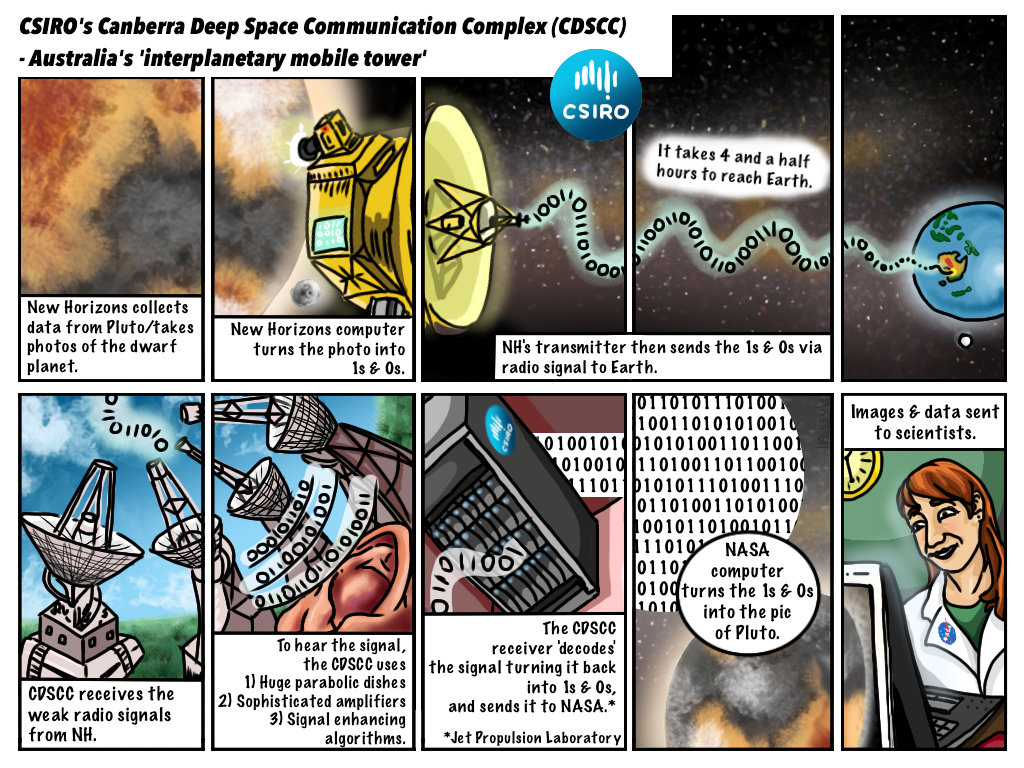…and 8 other cool New Horizon facts
We’re playing a vital role in NASA’s New Horizons mission, the first ever attempt to visit Pluto. Learn more about this historic exploration, and our other astronomical feats, at #CSIROSpace.
Interplanetary MMS explained.
Talk about a long distance call.
Some time tonight, around 9:57pm AEST, we’re expecting a world-first ‘phone call’ from the outer edges of the solar system.
The team at our Canberra Deep Space Communications Centre (CDSCC) will be the first to hear from the New Horizons spacecraft as it completes its nine-and-half-year journey to the solar system’s most famous dwarf planet, Pluto. NASA and Johns Hopkins University Applied Physics Laboratory are the lead agencies on this multi-million dollar project, but our CDSCC facility will be integral in communicating with the far-flung vessel.
Scientists have never before had an opportunity to study Pluto and its surrounding moons (Charon, Hydra, Nix, Styx and Kerebros) with such detail and precision. Even images from Hubble have shown us little more than blobs. Using an immense array of sensors and cameras, New Horizons will send us the most comprehensive images and data from the icy dwarf planet the world has ever seen. This information will not only shed new light on Pluto’s mysteries, but it will also help us better understand the origin and evolution of Earth and our planetary neighbours.
Before New Horizons reaches its mission objective, let’s find out a little more about this spacecraft and the amazing science powering it to Pluto.
- A long time ago: New Horizons (NH) blasted off from Cape Canaveral in Florida on the 19th January 2006: the same year the X-Box 360 was released in Australia, the Beaconsfield mine disaster hit the headlines and Peter Brock and Steve Irwin passed away.
- A powerful name: The probe is powered by a single radioisotope thermoelectric generator (RTG), which transforms the heat from the natural radioactive decay of plutonium dioxide into electricity. Can you guess which dwarf planet plutonium-238 is named after?
- An interplanetary pit stop: NH made a quick detour to Jupiter in 2007. During this interplanetary layover, the probe used the opportunity to test some of its scientific instruments, before using the gas giant’s gravity to give it a 14,000km/h slingshot towards Pluto.
- Short but sweet: It’s only going to be in range of Pluto for 5 hours, capturing immense amounts of data, before it starts a new mission. After Pluto, NH will venture on to the mysterious Kuiper belt.
- A close-ish encounter: NH will duck between Pluto and its neighbouring moon, Charon, before it skims approximately 12,500 kilometres above Pluto’s surface, unleashing its suite of scientific observations.
- Me first: Our CDSCC will be one of the first places on Earth to receive the data from New Horizons, in binary form (a massive cache of 1s and 0s)… which is great if you can read the Matrix.
- Whispers from space: By the time it reaches Earth, the radio signals from New Horizons are 20 billion times weaker than the power of a watch battery. These are the signals captured and processed by CDSCC’s giant antenna dishes before being sent to waiting mission scientists.
- Six of the best: Alice, LORRI, Ralph, PEPSSI, SWAP and Rex. No, it’s not the next team of contestants on The Voice – these are the names of the six scientific instruments mounted to New Horizons. The instruments are equipped to collect a vast array of information, and include imaging spectrometers, particle detection instruments and a passive radiometer.
- Students riding shot-gun: There is also a plus-one tagging along: a dust particle counter created by a group of students from the University of Colorado, which puts pretty much every other student group student project in the history of the world to shame.
Remember to check out #CSIROSpace for the latest updates!


